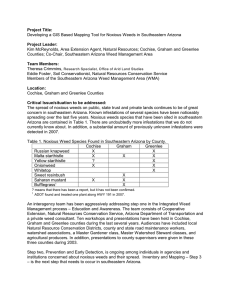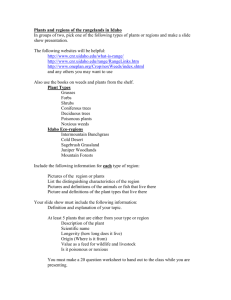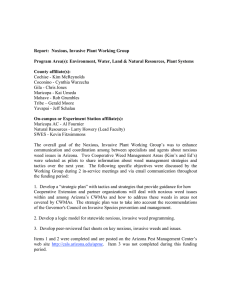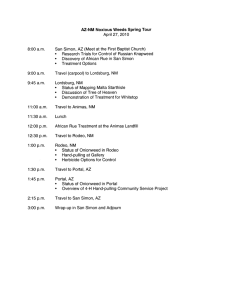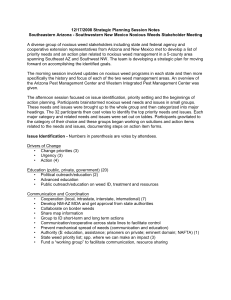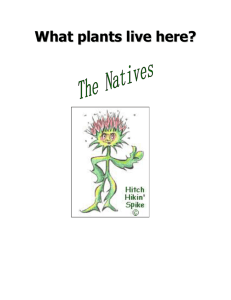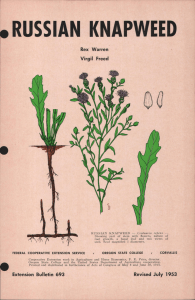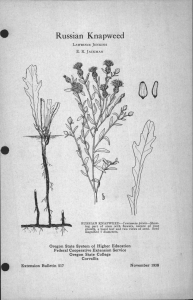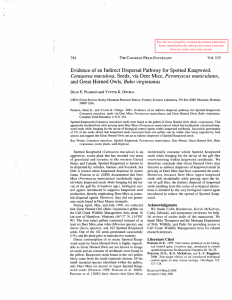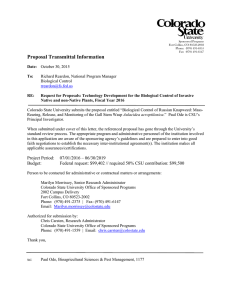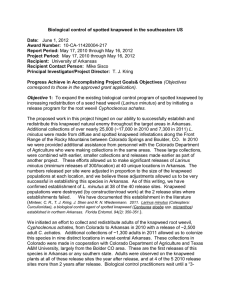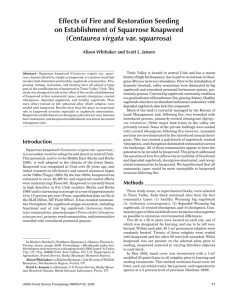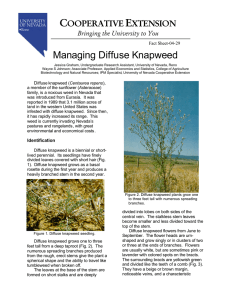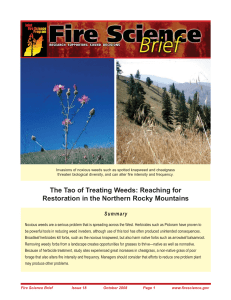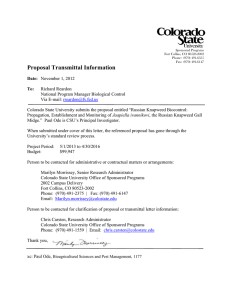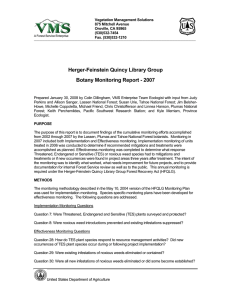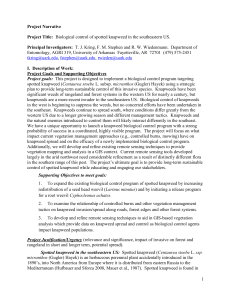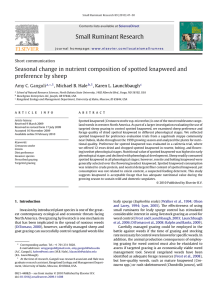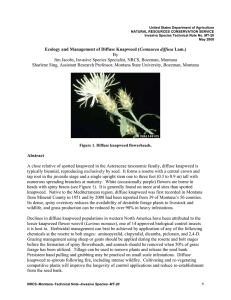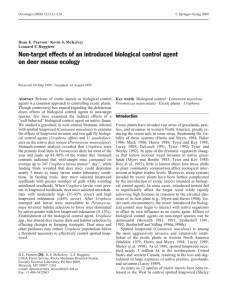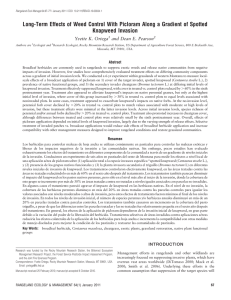Final Report Outputs:
advertisement
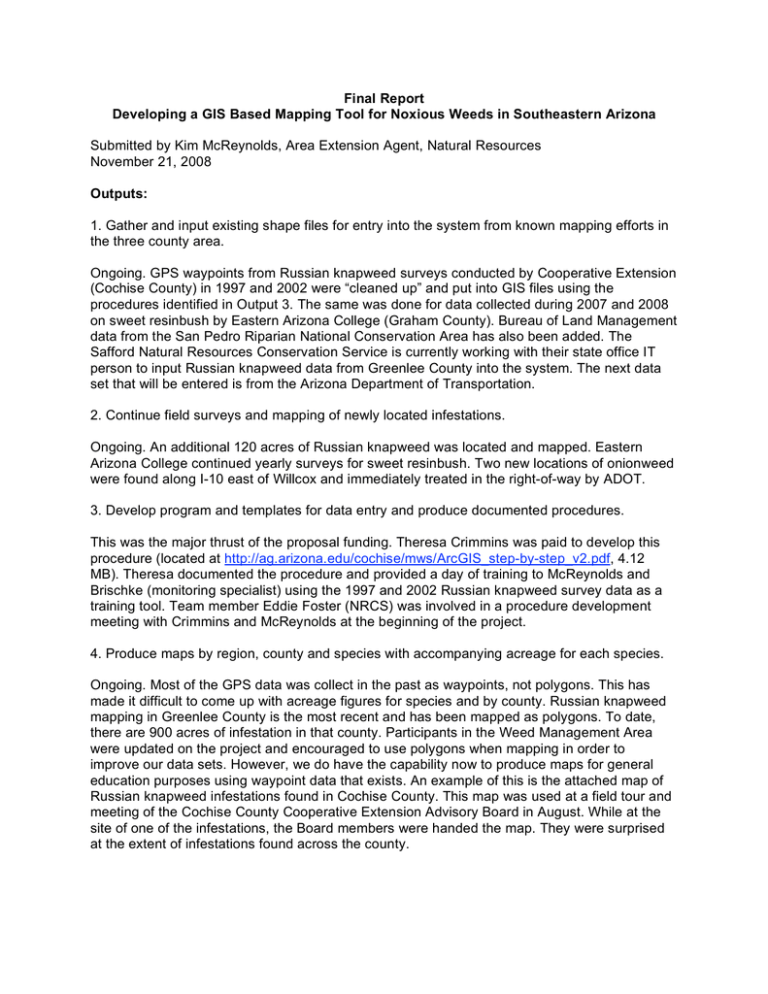
Final Report Developing a GIS Based Mapping Tool for Noxious Weeds in Southeastern Arizona Submitted by Kim McReynolds, Area Extension Agent, Natural Resources November 21, 2008 Outputs: 1. Gather and input existing shape files for entry into the system from known mapping efforts in the three county area. Ongoing. GPS waypoints from Russian knapweed surveys conducted by Cooperative Extension (Cochise County) in 1997 and 2002 were “cleaned up” and put into GIS files using the procedures identified in Output 3. The same was done for data collected during 2007 and 2008 on sweet resinbush by Eastern Arizona College (Graham County). Bureau of Land Management data from the San Pedro Riparian National Conservation Area has also been added. The Safford Natural Resources Conservation Service is currently working with their state office IT person to input Russian knapweed data from Greenlee County into the system. The next data set that will be entered is from the Arizona Department of Transportation. 2. Continue field surveys and mapping of newly located infestations. Ongoing. An additional 120 acres of Russian knapweed was located and mapped. Eastern Arizona College continued yearly surveys for sweet resinbush. Two new locations of onionweed were found along I-10 east of Willcox and immediately treated in the right-of-way by ADOT. 3. Develop program and templates for data entry and produce documented procedures. This was the major thrust of the proposal funding. Theresa Crimmins was paid to develop this procedure (located at http://ag.arizona.edu/cochise/mws/ArcGIS_step-by-step_v2.pdf, 4.12 MB). Theresa documented the procedure and provided a day of training to McReynolds and Brischke (monitoring specialist) using the 1997 and 2002 Russian knapweed survey data as a training tool. Team member Eddie Foster (NRCS) was involved in a procedure development meeting with Crimmins and McReynolds at the beginning of the project. 4. Produce maps by region, county and species with accompanying acreage for each species. Ongoing. Most of the GPS data was collect in the past as waypoints, not polygons. This has made it difficult to come up with acreage figures for species and by county. Russian knapweed mapping in Greenlee County is the most recent and has been mapped as polygons. To date, there are 900 acres of infestation in that county. Participants in the Weed Management Area were updated on the project and encouraged to use polygons when mapping in order to improve our data sets. However, we do have the capability now to produce maps for general education purposes using waypoint data that exists. An example of this is the attached map of Russian knapweed infestations found in Cochise County. This map was used at a field tour and meeting of the Cochise County Cooperative Extension Advisory Board in August. While at the site of one of the infestations, the Board members were handed the map. They were surprised at the extent of infestations found across the county. 5. Use maps in community presentations and in reports to County Supervisors to raise awareness and knowledge of noxious weeds. One presentation/workshop will be held in each county. • • • May 6, 2008, Clifton. Noxious Weed Presentation to Greenlee County Board of Supervisors. Used and handed out a GIS map of Russian knapweed to the Supervisors. There were 25 total people in the board room during the presentation. The editor of the Copper Era was also there and followed up with an article in the weekly paper. May 15, 2008, Duncan. Noxious Weed Workshop. General workshop using maps developed in GIS system. Attendance was 29, representing Greenlee County, ADOT, Fertizona, farmers, ranchers and interested public. Nineteen individuals signed up to stay involved in future workshops/field trips and for further information. August 4, 2008, Kansas Settlement. Presentation in the field to the Cochise County Cooperative Extension Advisory Board (18 people). See number 4 above. Because momentum picked up in Greenlee County, Graham County was not targeted for a program earlier this year. There will be a stakeholders meeting held in Safford on December 17, 2008 in which key players from that county will be invited to attend. Maps that were made as a result of the project will be displayed during the stakeholder meeting. These maps will aid in stakeholders prioritizing needs in the three counties. Expected outcomes and impacts Short: 50 people will increase their knowledge of noxious weeds in their local area and the threat that weeds pose. 72 attended either a presentation or workshop on noxious weeds. Additionally, the Copper Era published an article that included information on the threat of noxious weeds to the citizens of Greenlee County. Budget Requested funds $1,500 Expended $1,342 (Crimmins salary and ERE) Unexpended $ 158
